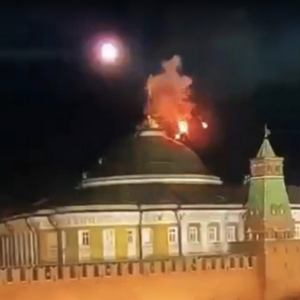Russia on Wednesday accused Ukraine of attempting to assassinate President Vladimir Putin by attacking his official residence using two unmanned aerial vehicles (UAVs). The Kremlin claimed “timely actions taken by the military and special services” disabled the drones using electronic warfare systems, resulting in no casualties or damage.
But video footage aired on Russian state TV appears to show a small drone crashing into the dome atop the Kremlin’s Senate Palace. Minutes later, another drone attacks the same target from a different angle, this time exploding just above the dome as two individuals — presumably state personnel — climb stairs running up the roof. However, the damage appears to have been minor.
The strike’s impact is chiefly psychological. It could prompt Russia to redeploy additional air defense assets to Moscow, potentially leaving other areas more vulnerable. But otherwise, the incident has little direct military impact. According to Putin’s spokesman, the Russian leader wasn’t at the Kremlin when the strike occurred. (He usually spends most of his time at his other residences.) The Kremlin said Moscow “reserves the right to take countermeasures wherever and whenever it deems appropriate.” But short of employing weapons of mass destruction, which seems unlikely, there isn’t much Russia could do to Ukraine that it hasn’t already done or attempted.
Kyiv officially denied involvement in Wednesday’s strike. A senior U.S. defense official likewise said Ukrainian officials “assure us it was not them,” noting that Kyiv did not provide Washington with “a heads up about the drone strike.” However, Ukraine appears to have (unsuccessfully) launched UAVs toward Moscow on multiple previous occasions, most recently in late April. In most instances, the attempted strikes used the UJ-22 Airborne, a Ukrainian-made, propeller-driven drone with a reported range of 800 kilometers when using preprogrammed coordinates. (The Kremlin is around 450 kilometers from northeastern Ukraine.) It remains unclear what kind of UAV was used this time around, but the drones appear to have been winged, like the UJ-22. It’s also unclear whether the drones were launched from Ukrainian territory or within Russia, perhaps by Ukrainian special forces.
Although Moscow is well-defended by Russian air defense and electronic warfare systems, small drones flying low and slow can be difficult to detect. In addition to satellite guidance, the UJ-22 reportedly has an inertial guidance system, providing redundancy (but decreased accuracy) against GPS jamming. Russia has reportedly stepped up GPS jamming in Moscow following the Wednesday strikes.
These recent UAV attacks are part of a long line of Ukrainian drone strikes and sabotage operations against targets deep in the Russian rear. Over the last week alone, a Ukrainian drone strike last weekend set ablaze a fuel storage facility in Russian-occupied Crimea. In Bryansk Oblast, which borders Ukraine, explosions derailed two trains carrying fuel. Later, drone strikes reportedly caused fires at a handful of oil facilities in southwestern Russia. On Wednesday, Russian Telegram channels reported that Ukrainian drones had attacked a military airfield in the Bryansk region, damaging an out-of-service An-124 Ruslan heavy transport aircraft.
Ukraine’s Air Force Command said Russian bombers fired 23 Kh-101 or Kh-555 air-launched cruise missiles at targets in Ukraine early Friday morning, then another 18 early on Monday morning. These were Russia’s first large-scale missile strikes in almost two months, likely reflecting Russia’s dwindling stocks. The Ukrainian military said its forces downed all but five of the missiles. But at least 23 people, including four children, reportedly died after a Russian missile struck an apartment building in Uman, located in Cherkasy Oblast in central Ukraine. Cherkasy’s governor said another missile struck a warehouse in the region.
According to Ukrainian Air Force spokesman Yuriy Ihnat, Moscow’s strategy has shifted. Last October, Russia launched a missile and drone strike campaign targeting Ukraine’s critical infrastructure, particularly its power grid, apparently aiming to erode Ukrainian will to fight. But that effort failed. Now, Ihnat says Russia is chiefly targeting Ukrainian weapons depots. A Ukrainian military intelligence official gave a similar assessment back in March, saying Russia had reoriented its strike campaign to focus on Ukrainian military facilities, troop concentrations, and logistics systems.
Following its May 1 missile barrage, Russia’s Defense Ministry said its forces had destroyed Ukrainian military-industrial facilities. Russia appears to have hit Ukraine’s Pavlohrad Chemical Plant, which produced components and fuel for various Ukrainian missile and multiple-launch rocket systems. The enterprise also housed decommissioned SS-24 ICBMs, and many expired rocket fuel, which probably caused a powerful explosion following the strike. The explosion caused extensive damage to nearby buildings. According to Ukrainian sources, the strike killed at least two members of Ukraine’s National Guard, who apparently belonged to a military unit tasked with protecting the plant and other important state facilities.
On Tuesday and Wednesday night, Russia launched barrages of Iranian-made Shahed-136/131 “suicide drones” at targets across Ukraine, fired from Bryansk Oblast and the Sea of Azov’s eastern coast. Ukraine’s Air Force Command said Ukrainian troops downed 21 of 26 UAVs during the first strike and 18 of 24 during the second.
But three drones reportedly did hit an oil depot in Kropyvnytskyi, in central Ukraine. Local authorities said other drones struck the administration building in Dnipro, destroyed an unspecified infrastructure object, and damaged five high-rises in Kostiantynivka, the key supply hub for Bakhmut in eastern Ukraine. According to the Ukrainian military, most of the UAVs launched on Wednesday night targeted Odesa, and three managed to strike dormitories at an “educational institution” in the city but caused no casualties. Unconfirmed reports from Russian sources show a large pillar of smoke rising from what they claim is the Odesa Military Academy.
A spokeswoman from Ukraine’s Operational Command “South” said the drone strikes aimed to reveal the positions of Ukrainian air defense systems. According to the Ukrainian military, Russia has recently begun using Shahed drones to draw out Ukrainian air defenses and then target them using Lancet loitering munitions.

